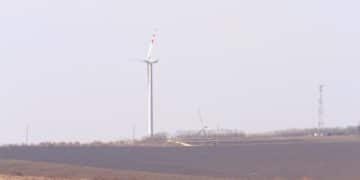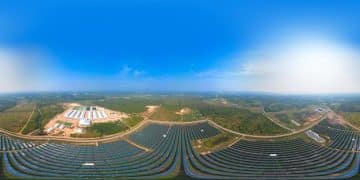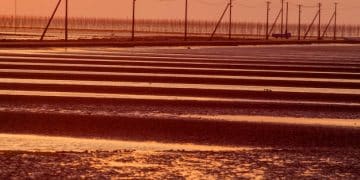Environmental Impacts of Wind Energy in the US: A Detailed Analysis
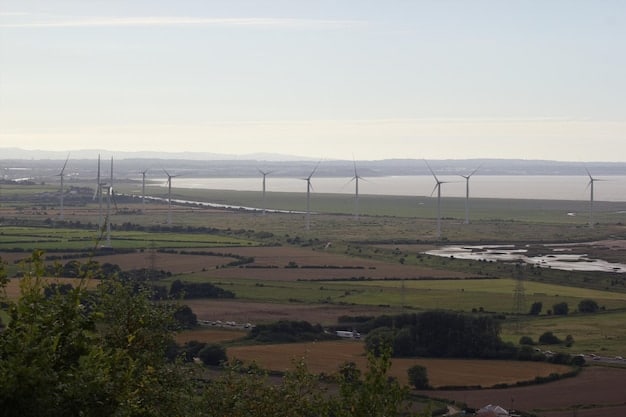
Large-scale wind energy development in the US has potential environmental impacts related to wildlife, land use, noise pollution, and visual aesthetics, requiring careful assessment and mitigation strategies to minimize negative effects.
As the US increasingly turns to renewable energy sources, wind power emerges as a key player. However, understanding what are the potential environmental impacts of large-scale wind energy development in the US is crucial for sustainable implementation and responsible energy production.
Exploring the Landscape of Wind Energy in the US
Wind energy has become a significant contributor to the US energy mix, offering a cleaner alternative to fossil fuels. To understand better the environmental implications, we must first examine the scale of wind energy development across the United States.
Across the United States, wind farms are now a common sight, dotting landscapes from the Great Plains to the Appalachian Mountains. This widespread deployment raises important questions about its environmental footprint.
Growth of Wind Energy
The expansion of wind farms has surged in recent years, driven by factors such as technological advancements, government incentives, and growing environmental concerns. This rapid growth has led to both economic benefits and environmental challenges.
Geographic Distribution
The geographic distribution of wind energy facilities varies widely across the country. Regions with high wind potential, such as Texas, Iowa, and Oklahoma, have seen the most significant development.
- Texas leads the nation in wind energy capacity, with substantial wind farms that contribute significantly to the state’s electricity generation.
- Iowa relies heavily on wind energy, with a large percentage of its electricity coming from wind turbines.
- Oklahoma has also experienced substantial growth in wind energy, capitalizing on its favorable wind resources.
In conclusion, to grasp the environmental effects, it is imperative to study the extensive growth and widespread geographic distribution of wind farms across the United States. This knowledge provides a structured framework for future explorations into the detailed ecological impacts in the chapters to follow.
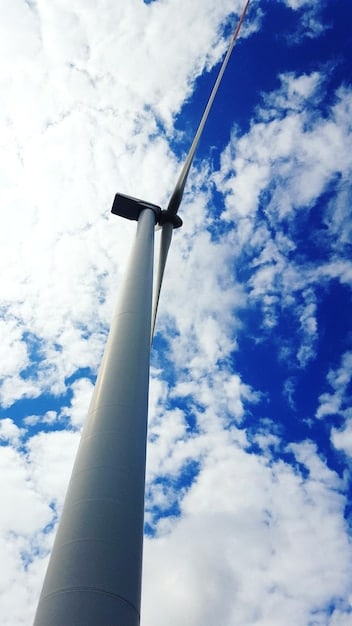
Impact on Wildlife and Biodiversity
One of the primary environmental considerations associated with wind farms is their impact on wildlife and biodiversity. Turbines can pose risks to birds and bats, and habitat disruption from construction can affect local ecosystems.
The interaction between wind farms and wildlife is a complex issue that requires careful study and adaptive management strategies. Mitigation efforts are essential to minimizing the negative effects on avian and bat populations.
Bird Collisions
Collisions with wind turbines are a significant concern for bird populations. Factors such as turbine height, blade speed, and geographic location can influence the frequency of bird strikes.
Bat Fatalities
Bats are particularly vulnerable to wind turbines due to their echolocation abilities, which may not effectively detect moving turbine blades. Consequently, bat fatalities at wind farms are a major concern.
- Migratory patterns of bats often intersect with wind farm locations, increasing the risk of collisions during seasonal movements.
- Specific bat species, such as hoary bats and silver-haired bats, appear to be more susceptible to turbine-related fatalities than others.
- Mitigation techniques, such as increasing cut-in speeds (the wind speed at which turbines begin to operate), have been implemented to reduce bat fatalities.
In conclusion, wind energy development poses real hazards to wildlife and biodiversity, making thorough assessments, ongoing monitoring, and clever mitigation necessary to reduce associated ecological effects.
Land Use and Habitat Alteration
Wind energy projects require significant land areas for turbine placement, access roads, and substations. This can lead to habitat alteration, fragmentation, and impacts on local ecosystems.
Strategically managing land use and implementing restoration efforts can mitigate the habitat alteration caused by wind farms, ensuring the long-term health of impacted areas.
Habitat Fragmentation
The construction of wind farms can lead to habitat fragmentation, dividing large, contiguous areas into smaller, isolated patches. This fragmentation can disrupt wildlife movement, reduce genetic diversity, and alter ecological processes.
Soil Erosion and Compaction
Construction activities associated with wind energy projects can result in soil erosion and compaction, particularly during the development of access roads and turbine foundations. These disturbances can affect vegetation growth and water infiltration.

To conclude, land use ramifications of wind energy development highlight the necessity of strategic site selection, extensive ecological studies, and the execution of land restoration and management to mitigate ecological disturbances and preserve biodiversity, thereby establishing a more harmonious coexistence between wind energy infrastructure and the natural environment.
Noise and Aesthetic Impacts
Wind turbines generate noise from both mechanical components and the aerodynamic interaction of blades with the wind. This noise can affect nearby residents and communities, leading to concerns about quality of life.
Addressing noise and aesthetic impacts through strategic turbine placement, noise reduction technologies, and community engagement can help mitigate these concerns, fostering positive perceptions of wind energy development.
Noise Pollution
Wind turbine noise typically consists of two components: mechanical noise from the gearbox and generator, and aerodynamic noise from the movement of blades through the air. The aerodynamic noise, often described as a “swishing” or “whooshing” sound, is typically the dominant source.
Visual Impacts
The visual impact of wind turbines on the landscape can be a contentious issue. Some people view wind turbines as a symbol of clean energy and progress, while others find them to be visually intrusive and detrimental to scenic vistas.
- Turbine height can exacerbate visual impacts, as taller turbines are visible from greater distances, affecting more residents and communities.
- Cumulative effects of multiple wind farms in a region can intensify visual impacts, leading to concerns about landscape industrialization.
- Mitigation strategies, such as careful siting and the use of consistent turbine designs, can help reduce visual impacts.
Effective community engagement, advanced noise reduction technologies, and mindful landscape integration are thus essential in mitigating the sound and aesthetic effects of wind energy development. By tackling these specific difficulties, we can guarantee a more harmonious coexistence between wind farms and surrounding habitats and communities.
Water Use and Hydrological Effects
Water usage in wind energy operations is generally low compared to other energy sources. However, water is required for turbine manufacturing, construction, and maintenance, particularly for cleaning blades and cooling systems. The effects on nearby aquatic settings and water resources need considerate assessment and administration.
Sustainable water management strategies, such as rainwater harvesting and closed-loop cooling systems, can help minimize water use in wind energy operations, ensuring the long-term availability of water resources.
Manufacturing and Construction
Water is used in the manufacturing of wind turbine components, including the production of steel, concrete, and composite materials. In addition, water is required during the construction phase for dust suppression, concrete mixing, and equipment cleaning.
Operational Water Use
During operation, wind turbines may require water for blade cleaning to remove accumulated dirt, dust, and ice, which can reduce aerodynamic efficiency. Water is also used in some cooling systems to regulate turbine temperatures.
Effectively, appropriate water management techniques, technical developments which minimize water intake, and thorough ecological evaluations are crucial for protecting water supplies. This strategy guarantees the enduring environmental and economic feasibility of wind energy projects by minimizing strain on local water sources.
Carbon Footprint and Life Cycle Analysis
While wind energy is a renewable and low-carbon energy source, it is not entirely free of greenhouse gas emissions. A careful life-cycle evaluation is crucial to adequately evaluate the carbon footprint of wind energy deployment, encompassing construction, operation, and decommissioning.
Comprehensive life cycle analyses can provide valuable insights into the overall environmental performance of wind energy, guiding decisions to reduce carbon emissions and improve sustainability.
Manufacturing and Materials
The manufacturing of wind turbine components, such as blades, towers, and generators, requires energy-intensive processes that result in greenhouse gas emissions. The extraction and processing of raw materials, such as steel, aluminum, and fiberglass, also contribute to the carbon footprint.
Transportation and Installation
The transportation of wind turbine components from manufacturing facilities to project sites can involve significant distances and energy consumption. Installation activities, including crane operations and foundation construction, also contribute to emissions.
- Optimizing transportation logistics and using more efficient transportation methods can reduce emissions associated with component delivery.
- Adopting cleaner construction practices, such as using hybrid or electric equipment, can minimize emissions during the installation phase.
- Investing in research and development to develop lighter and more recyclable turbine components can further reduce the carbon footprint.
Complete life cycle evaluations are basic to quantifying and dealing with the carbon footprint of wind energy advancement. This entails taking into consideration emissions from manufacturing, implementation, operations, and decommissioning, as well as emphasizing practices to guarantee wind energy’s long-term contribution to a sustainable energy future.
| Key Point | Brief Description |
|---|---|
| 🦅 Impact on Wildlife | Bird and bat collisions are a significant concern, requiring mitigation strategies. |
| 🏞️ Land Use | Wind farms require substantial land, leading to habitat alteration and fragmentation. |
| 🔊 Noise Pollution | Turbines generate noise that can affect nearby communities and quality of life. |
| 💧 Water Usage | Water is needed for manufacturing, construction, and maintenance, requiring careful management. |
Frequently Asked Questions
▼
The main environmental concerns include wildlife impacts (bird and bat fatalities), land use changes, noise pollution, visual impacts, and the carbon footprint of manufacturing and installation.
▼
Wind farms can cause fatalities in bird and bat populations due to collisions with turbine blades. Mitigation strategies include adjusting turbine placement, increasing cut-in speeds, and using deterrent technologies.
▼
To minimize land use impacts, careful site selection, habitat restoration, and land management practices are implemented to reduce habitat fragmentation and soil erosion.
▼
Noise pollution from wind turbines is addressed through strategic turbine placement, noise reduction technologies, and community engagement to ensure the surrounding residents are not significantly affected.
▼
While wind energy is low-carbon, manufacturing, transportation, and installation of turbines do produce emissions, these phases need to be included in a life-cycle assessement to determine the carbon footprint.
Conclusion
In conclusion, while wind energy offers a promising pathway towards a sustainable energy future in the US, it also brings potential environmental impacts that must be carefully considered and mitigated. By addressing these challenges with thorough assessments, innovative technologies, and responsible land management practices, we can harness the benefits of wind energy while minimizing its environmental footprint and securing a greener future.
